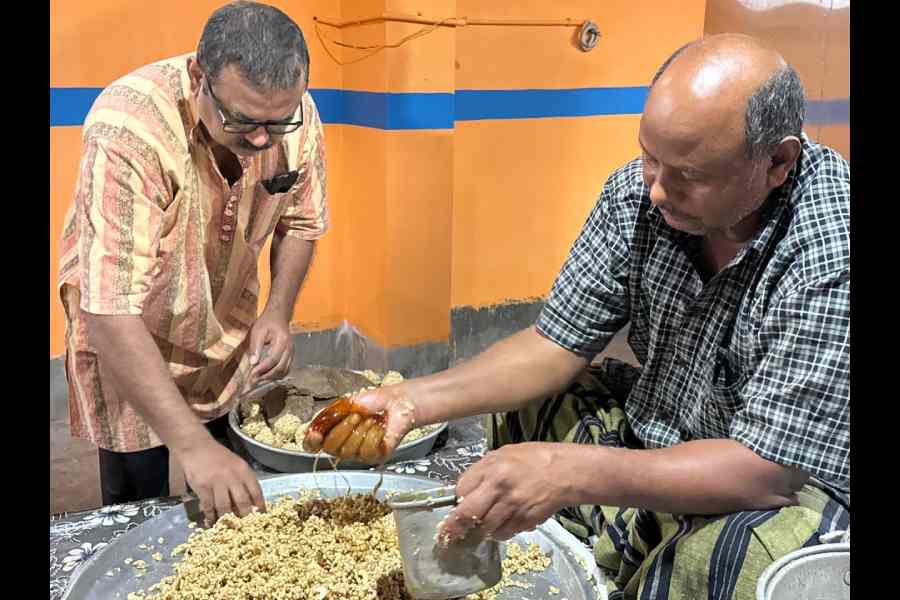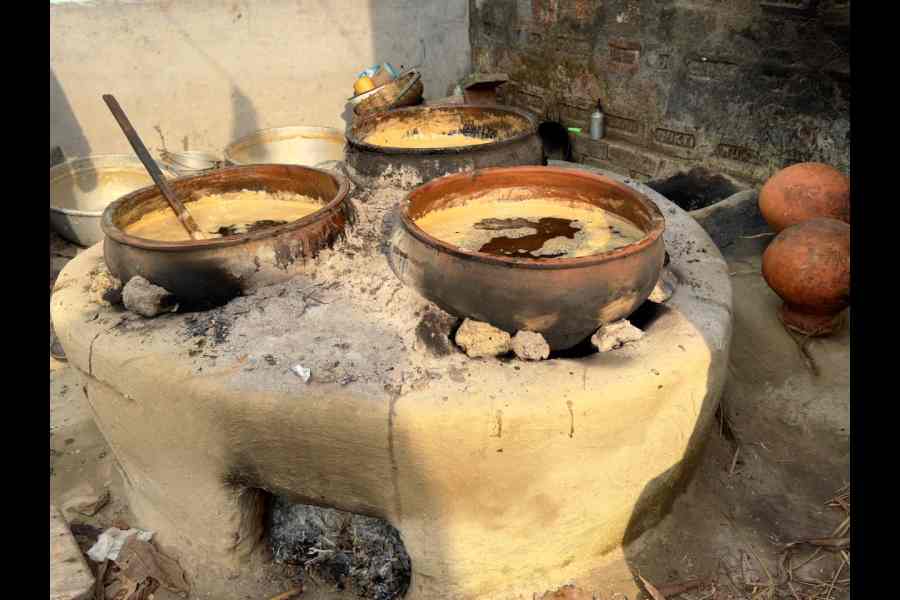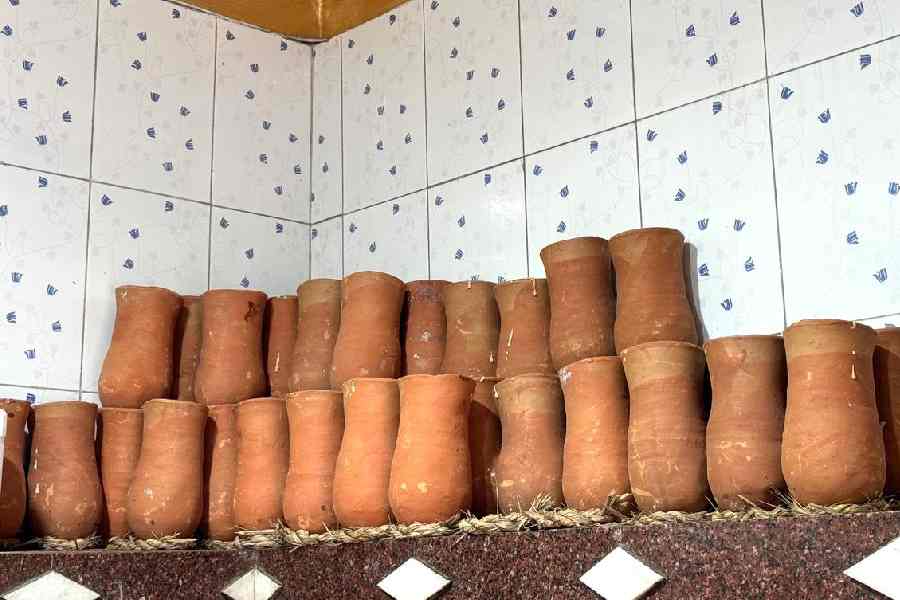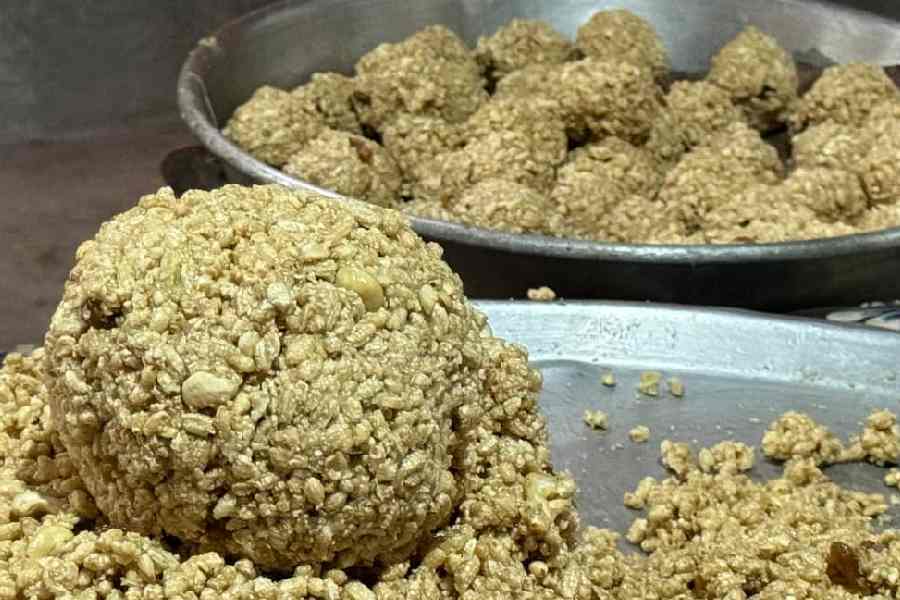The first box arrived at the tail end of November from a north Calcutta bazaar. Every bite presented a varying degree of blandness, highlighting the sway a “brand” can have over us. Years of having the real thing has added enough experience to my girth to separate the fake from the real thing. C’mon, that surely cannot be moa from Joynagar however much the font size shouts out. To settle the craving for the famed Bengali winter delight, last Sunday, the car rolled out at 5am because Joynagar was calling. Actually, Baharu was calling.
The two-hour drive was punctuated by a couple of tea breaks and Hemanta Mukherjee’s ever-soothing voice. After all, it was a trip to a town he called his own for the first eight years of his life. A few days before the trip, I made one call and that was to Shyamsundar Mistanna Bhandar, one of the oldest shops in Baharu selling authentic Joynagar-er moa. The purpose was simple: Get the timing right.

The facade of Shyamsundar Mistanna Bhandar in Baharu
In case you are the kind of person who wants to see every step of the process, you should reach Baharu around the crack of dawn to see how seulis tap date palm trees and then comes the process of making nolen gur, followed by the making of the sweet. I am only an expert at eating, so it was the moa-making process that I wanted to see. To see the nolen gur-making process, you need to find the locations from the many local sweetshops.
Uncompromised quality
By the time I reached Shyamsundar Sweets, it was around 7.20am and the crowd was beginning to file in. After some chitchat with Ranjit Kumar Ghosh, one of the current owners, I found out that his father, Gopal Chandra Ghosh, established the shop. To throw in a with-it phrase, moa, back then, hadn’t gone “viral” and most of the fare that came from Joynagar to Calcutta was authentic. Much has changed.
He explained that moa is not about doling out an overload of sweetness. A lot depends on the quality of nolen gur, ghee and, of course, popped rice or khoi. After several tries, he got the proportion of the ingredients right. Each time you pick up a piece of moa from here, your fingers will surely be lick-worthy and covered in a film of ghee.
As he spoke, my eyes caught the many pictures of him with Sourav Ganguly in his Dadagiri avatar. Ensuring operations are smooth, Ranjit is kept company by his brother, Bablu. Winter is obviously dedicated to moa while the rest of year, the shop sells a variety of other sweets.

Khoi from Kanakchur dhaan
Soon, we were walking narrow lanes, going around ponds, looking for artisans making nolen gur. On our second attempt we found one, though the process was almost near its end. I was told that it takes long, labour to prepare the golden syrup almost every Bengali loves. As the temperature dips further, the quality of gur will get better.
As important as the liquid date palm jaggery is the quality of khoi, which, in the case of Baharu, comes from Kanakchur paddy cultivated in the Joynagar region. It’s long and white, making it geographically unique. No wonder Joynagar-er moa received the Geographical Indication (GI) tag in 2015.

Shri Krishna Mistanna Bhandar, one of the early shops that gave Joynagar moa its branding
I was back at the sweetshop and even though I sat through the entire moa-making process, I still haven’t understood the proportions. All I know is that with every sprinkling of nolen gur, the mix took on a beautiful golden hue and the beautiful smell of ghee formed a film around my nose. All the while, customers kept dropping by, asking for anything between five to 20 packets of moa.

The fare at Shyamsundar Mistanna Bhandar in Baharu
Minimum standard

Ranjit Kumar Ghosh (right) and his brother Bablu ensure that the fare at Shyamsundar Sweets retains its high quality. They begin work around the break of dawn when moa is in season
There is very little to fall back on to discuss the history of this unique sweet. It must have been around for a long time but it took two young men to give the sweet proper branding. It’s said that Purnachandra Ghosh (Purna) and Nityagopal Sarkar (Buchki), of Joynagar, came up with their shop Shri Krishna Mistanna Bhandar in 1929. It’s still up and running. Even though it was a Sunday, the car crawled its way through to Joynagar and I caught a glimpse and taste of moa from this famous address. If you ask me the difference between the many moas I had last week, I would say, it’s about the amount of dry fruits.

Nolen gur is a key ingredient in the moa-making process. It’s time-consuming and needs constant supervision
Back in Baharu, Ranjit Kumar Ghosh explained that it’s getting tougher to find enough seulis, who are looking at other options of livelihood. Also, the quality of khoi needs to be maintained.
Next came a query from a school friend who now lives in New York: Can these be enjoyed over a few days? The answer is yes. Given the current temperatures, you can easily store it for four to five days. Some shops are even trying different packaging methods to increase shelf life.

Clay pots in which nolen gur is sold
Having the GI tag ensures moa from this region abides by certain standards. Most of the moa are between 50g and 75g in dry weight. A close eye is also kept on the amount of ghee, cardamom, khoya, kheer, cashew nut and so on.
At my place, the next few weeks will bring several packs of moa from different shops in Calcutta. I know most of them will not have the rich molten goodness of Joynagar-er moa but it’s a winter ritual I don’t intend to turn my back on. Till my next visit to Joynagar — frankly, I don’t know when — I will remember that I went to Hemantada’s town, returning with packets of moa and bottles of nolen gur while listening to the man sing: Na yeh chand hoga, na taare rahenge/ Magar hum hamesha tumhare rahenge. Maybe you should plan a visit to Baharu next week.
